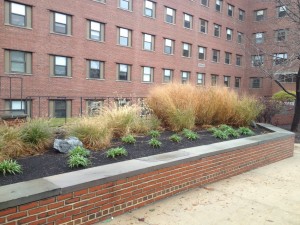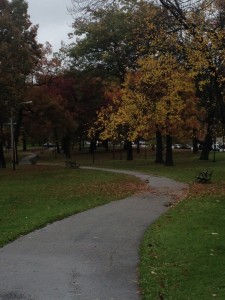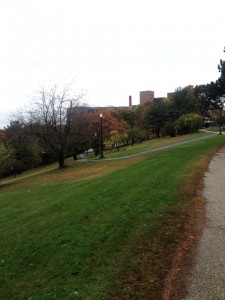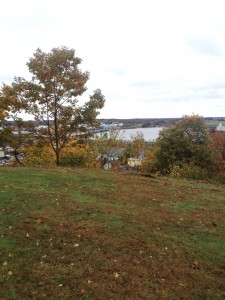I conducted a transect walk through the West End with fellow Public Space group members, Libby and Jackie. We decided to focus on public seating and learn from the William Whyte video to observe the state of usable public seating in Portland’s West End. Our observations indicate a need for more public seating facilities, but perhaps more importantly, better maintenance of current seating facilities. There is great potential for the two parks we visited to be improved; I would recommend the City dedicate their funds to first improving the Western Promenade and Deering Oaks park before setting plans to install any new parks. I also would recommend that public art installations be shaped around seating – either making the art the seat itself or creating art near pre-existing seating to make it more inviting.
Our walk began at Pine St. and State St. and we headed west to the Western Promenade. We could not find any public seating on our way to the Promenade, which was quite surprising to us since we perceived ourselves to be in one of Portland’s most wealthy residential neighborhoods. We spotted a tree stump early in our walk and given the lack of traditional seating (benches, ledges, etc.), we proclaimed that if they had cut the tree a little higher then the stump would be a wonderful seat! We thought about the potential for having a series of stumps that could be carved by local artists and then lacquered for longer wear.

The tree stump that inspired our “nature” seating idea.
We spent quite some time exploring the Promenade, which had exactly six benches, all of which were very run-down and not aesthetically pleasing. The placement of the benches was rather unusual – they were awkwardly spaced and faced out toward some trees and shrubbery (some of which had been cut down) overlooking the water. A water view sounds appealing, however, the inlet is surrounded by industrial buildings, large storage tanks, and the airport – not exactly what I would like to look at for a long period of time. We struggled to understand why the park designers had placed the benches in such a manner. Would it not be more pleasing to have the benches turned the opposite way facing the lawn? And perhaps fill the lawn with some gardens and more trees? Or level a section of it out and make it a soccer field, play ground, or recreation area? We saw three people while we were at the Promenade, all had dogs. Why not make part of it into a dog park? They could easily install a dog tap for water along with some doggie bags, a physically fenced in area is not necessary. The paths did not make much sense to us either – three different materials were used and the path which housed all the benches was very broken and poses a safety risk to anyone walking or running along it. The lighting fixtures in the park were inconsistent, as well. The area mostly left us feeling confused, wondering who would come here and what they would do.
The winding paths on the northern end of the park which were very confusing to us. They were very narrow and at a steep incline which would make it difficult for older residents to use.
A view of the industrial area below.
One of the three types of paths at the Western Promenade, looking old and grown in.
All of the benches looked like this one. Old, moldy, and not very comfortable looking (no arm rests even!).
We headed North from the Promenade past Maine Medical Center. There was some seating outside the hospital entrance, however, it faced the side of the building rather than the street. The height of the seating was ideal, but it was rusting and old. It also did not appear as though it was very well-cared for.
The blue rusted seating facing a brick wall.

Here is our first example of some usable public seating outside the hospital. The ledge is a good height and depth, it is facing the street, and the flower bed can be planted with aesthetically-pleasing arrangements to attract people.

Across the street from the hospital is a parking lot with a stone wall that has so much potential for seating, but the railing is stuck right in the middle so seating is not even a possibility. It is such a shame that patients and hospital employees lack opportunities to sit outside for lunch or an afternoon break.
A seating area at the corner of Deering St. and Congress Ave. where two of the three benches sit side-by-side with a garbage bin – not exactly the most inviting space for people to want to sit for an extended period of time. The third bench (not pictured) is looking away from the others, isolated all on its own.

We made our way north to Deering Oaks park, which was definitely the most encouraging public space we visited, particularly for seating. There was a string of benches bordering one of the winding paths. We did spotted one lone picnic bench; however, it was placed in a random location. We noticed the lighting fixtures were, like the Western Promenade, inconsistent – some were black lanterns while others were grey and ugly. The pond is a great feature, but there are no paths built along it and no seating nearby. How are people supposed to be able to enjoy the fountain and watch the ducks if there is limited access and no facilities to sit? Furthermore, the park needs a physical or psychological barrier to separate it from the traffic driving by. I know I would be much more likely to want to spend time there if the visual and audio effect of the cars did not disrupt the peace of being immersed in nature.
Coordinates:







Emma,
In general, I think Portland would benefit from some more physical and psychological barriers to define its spaces. One of the best feelings a public park can create is that of a small getaway within a city—a place to be used and enjoyed in a different way from the sidewalks and shops. It is very difficult to mentally access park spaces in a meaningful way if the park feels like a median strip between streets, rather than a secluded green pocket of the city. Your point about psychological barriers is important— noise has a huge impact on our perception of a space, and regardless of its geography, something usually feels very close if it can be heard clearly or constantly.
Eva
As you know, I really like the idea of artist-carved tree stumps as seats, it is a great combination of public art, seating, and repurposing of old materials. I also think it is very true that we should focus on improving existing parks instead of creating new ones. It is a common request for a city to have more green space — we even had some of our map makers suggest that — but ultimately, Portland does not need more as much as it needs more effectively utilized parks. Deering Oaks Park and the Western Promenade are expansive and in close proximity, giving locals a large amount of park space, but neither is very desirable. We need to focus resources on improving what we already have.
I agree with every thing that you mentioned concerning public seating. As we conducted this walk, most of what we noted about public seating turned into cynic and sarcastic comments, which is a sign about the lack of usable or inviting public seating throughout Portland. Particularly in the West End Promenade, the lack of appropriate seating makes the entire area look desolate and unusable. I agree with your comments about the poor planning of bench placement. With all of the 6 benches throughout the Western Promenade overlooking the industrial view of the city, rather than spaced closer together and on the green areas surrounded by gardens and trees. Eva brings up a good point that this area should serve as a getaway feeling in a big city, and a change in the placement of benches could channel this vibe more so than its current state.
Emma, I really enjoyed reading this! I as well visited the Western Promenade. It was around sunset and the sun was casting it all in gold. It seems like that narrow strip of park is squished up against the cliff, and also strange that the road parallel to it is so wide, though this also makes it more accessible to not just the people in the wealthy neighborhood. The narrowly winding path down the side of the steep hilltop was quite confusing. I don’t think I would want to venture down it, but someone did find a good use for it: a longboarder practicing sharp slides with his friend sitting nearby. I saw a variety of people, though many dog walkers just like you mentioned. There was a couple having a picnic on a blanket as well as two other people using a wide tree stump as a table for some business they were discussing.
I liked your idea for carving practicality out of nature. Trees are more integrated into the environment and sure, need not be removed because they can have the dual purpose of being functional and aesthetic. It also takes the middleman of getting logged wood to construct seating; instead it goes directly to the artist to work on and in this way supports local artists, betters public space and saves resources.
What if artists took old fishing net and constructed innovative public seating with it? For example, the rope nets can be repurposed at the same time as having this Maine motif be the material — hanging swing seats, soft seating and hammocks.
The idea of transforming tree stumps into seats is really interesting–practical and aesthetically appealing. I agree with Annie in her idea of fishing net as seating. Both are ways to recycle materials into other practical resources. Additionally, they can incorporate cultural aspects that “define” Portland, such as the use of fishing materials.
I have also found that the bench placement is lacking. As I’ve observed, the placement of seating in Portland suggests that benches are intended as places to rest while in transit, rather than destinations. This is good for resting, but how could they attract more people? As you suggest, a good solution would be adding other aspects that would attract people to the parks as a destination, such as public art displays, dog parks, playground, or other multipurpose areas.